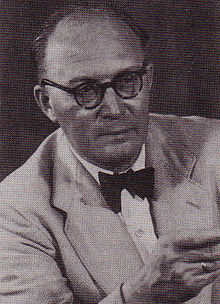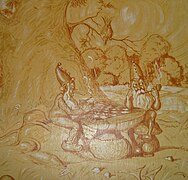Helmut Lewin

Helmut Lewin (born October 10, 1899 in Schneidemühl , Province of Posen , † March 6, 1963 in Swakopmund , South West Africa , today Namibia ) was a German portrait and landscape painter who became one of the most popular native painters in South West Africa. By profession he was actually an architect and for a short time also the city architect of Windhoek (Namibia).
Life
Lewin was born the eldest of nine children of a chief insurance inspector in the province of Poznan. The father, descendant of a farming family, died quite early. So Lewin had to leave school and start an apprenticeship as a bricklayer to help support the extended family. At the age of 18, he began as a draftsman in an aircraft construction company, where he stayed until the end of the First World War .
The widowed and childless company owner recognized Lewin's talent as a designer and sent him after the war in 1919 with a scholarship to Weimar at the Bauhaus , where he studied architecture with Professor Walter Gropius (1883–1969) until 1923 . But Lewin soon turned secretly to painting.
He studied with Max Thedy (1858–1924), whose last master class he was, and with Felix Schwormstädt (1870–1938) and only later admitted his artistic ambition to his patron . She was generous and continued to support him. In Weimar Lewin also met his future wife Eva, who also studied painting there and whom he married in November 1923. The young couple moved to Schwerin ( Mecklenburg ) where Lewin a job at the Commercial High School was where he was younger than many of his homecoming from the war students.
Because of the economic crisis in post-war Germany and the consequences of the inflation of 1923, Lewin drew up the plan in 1924 to emigrate to the formerly German colony of German South West Africa (today: Namibia), finally emigrated in 1926 initially alone and began working as an architect in Windhoek . In 1927 the family followed and they settled in Otjiwarongo .
In Otjiwarongo, Lewin a. a. a huge frieze in the hotel "Hamburger Hof" with 30 large paintings al fresco in the dining room of the hotel. After the family moved to Omaruru in 1934 , Lewin decorated the walls in the Kölling Hall there with a few caricatures. In the Jacoby hotel, too, he painted a wall frieze with pictures of animals and caricatures from everyday life in South West Africa. In 1937 he designed the new cemetery chapel in Omaruru.
In 1935, the Lewin couple tried to lease a hotel in Otavi . Business developed quite well at first, but when his wife fell ill and went to Germany for medical treatment with the children in June 1939, the hotel was given up again. Lewin wanted to follow later, but the Second World War broke out - and Lewin had to hide from the South African (British) authorities in the interior of South West Africa in order not to end up in an internment camp as a German prisoner of war .
Because of a sarcoma and the associated risk of death, he finally had to face the authorities after a year. Behind barbed wire in the internment camp "Andalusia" ( Republic of South Africa ) he created some of his best works, a series of portraits and depictions of war and death, including the paintings "The Grave in the Snow" , "2000 Years of Christianity" , "Self-Portrait with Death" and “Hero's Shrine” , which is now on display in the Swakopmund Museum .
In 1944 Lewin was repatriated to Germany as an "exchange prisoner" and went back to Schwerin. After the war, his South African passport saved him from being abducted to Siberia by the Russian occupation forces . As a foreigner he was sent to the west by train and the family settled in the Pinneberg area near Hamburg . For three years (1946–1949) Lewin painted portraits of American soldiers from photos and was a lecturer at the University of Hamburg . Then he went back to his African homeland.
In December 1949 the family emigrated again to South West Africa (Namibia). Omaruru, Karibib , Windhoek and Swakopmund were the stations of life there. Through numerous exhibitions he became one of the most popular landscape and local painters.
Shortly after his last exhibition in Swakopmund, where he lived, Lewin died of cancer at the age of 64. He was buried in African soil on the farm “Bitterwasser”, the farm of the younger daughter Brigitte. His last wish was: "Let grass grow over it."
Act
As an architect
As an architect, he designed a number of public buildings in various cities in Namibia. For a short time Lewin worked as a city architect in Windhoek. His plans include u. a. the official city coat of arms ( see picture ) and the redesign of the old zoo in the " Verwoerd-Park ".
As a painter
The Allgemeine Zeitung wrote about his exhibition in Otjiwarongo in August 1933 : “Lewin is an extraordinarily versatile artist; Animal pictures, landscapes, portraits and caricatures were created in quick succession, and some pieces adorn Südwester Heime today, some found their way overseas. "
His pictures found their way into museums and private collections and are still traded at auctions today.
In his landscape motifs, Lewin often used a rather unusual perspective: he limited himself to a small section and looked at it from the ground as if from the eyes of a small bird.
Exhibitions
During his lifetime Lewin organized numerous exhibitions in various cities in South West Africa (including Otjiwarongo, Windhoek, Swakopmund) as well as in Germany and Portugal .
Some of his paintings are in the collection of the Arts Association Heritage Trust (AAHT), which is kept by the National Art Gallery of Namibia (Windhoek). More pictures can be found in the Swakopmund Museum .
Omaruru -uppe
(1945, watercolor)Omatakoberge
(1947, oil painting)Guinea fowl on termite mound
(1948, color drawing)Aloe Hill
(oil painting)
source
- Eva-Maria Linsmayer: The painter Helmut Lewin (1899–1963). In: Namibiana. Issue 11, page 91f., SWA Wissenschaftliche Gesellschaft (Ed.), Windhoek 1987, ISSN 0259-2010
Web links
Individual evidence
- ↑ Albert Bourquin: Omaruru. History of a City , unpublished manuscript, Dec 1969, p. 200
- ↑ Eva-Maria Linsmayer (1925–2009) was the painter's older daughter alongside the younger Brigitte; she died according to an obituary in the Allgemeine Zeitung on July 21, 2009 in Cape Town at the age of 84.
| personal data | |
|---|---|
| SURNAME | Lewin, Helmut |
| BRIEF DESCRIPTION | German-Namibian genre painter, portrait and landscape painter and architect |
| DATE OF BIRTH | October 10, 1899 |
| PLACE OF BIRTH | Schneidemühl , Poznan Province |
| DATE OF DEATH | March 6, 1963 |
| Place of death | Swakopmund , South West Africa , today Namibia |










